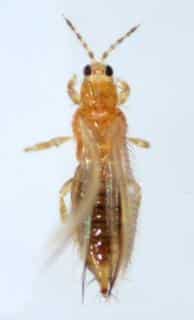There are nearly 6,500 identified species of thrips, but many more have yet to be discovered and named!
Key facts about thrips species
Order – Thysanopthera
Sub-orders – Tubulifera & Terebrantia
Distribution – Worldwide
Number of species – 6385 and counting
→ Tubulifera: 3716 species
→ Terebrantia: 2669 species
Biologically, thrips are divided into two large sub-orders based on the tip of their abdomen. These sub-orders are further divided into dozens of genera, each counting hundreds of species.
Read also:
Two sub-orders in the Thrips order
Common traits thrips species share
The thousands of thrips species vary wildly in shape and size, but they all share common traits.
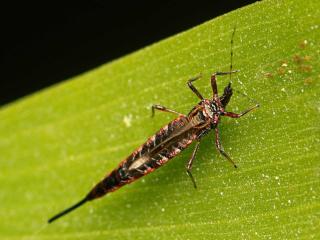 Shape is oval, and like all insects they have 6 legs.
Shape is oval, and like all insects they have 6 legs.
- Their mouthpieces are asymetrical: one side is much larger than the other. This is impossible to see without a powerful microscope, though.
- For many species (but not the majority), a pair of fringed wings – fringed as in, made from tiny frills like a bird’s feather – is often seen folded along their backside.
- They’re all tiny, between a fraction of an inch to at most 1/8th, or 0.2 to 3 mm, although a few rare species grow to nearly half an inch (15 mm).
- All but a few species of thrips lay eggs. These are tiny, translucent-white and are round, bean-shaped or oval (like tiny grains of rice).
Much variation even within a thrips species
However, even within a single species individuals may vary greatly from one to the next. Two siblings might not be of the same color. Markings along the tiny body also are unique to each individual!
- Moreover, sometimes generations are different simply based on when they emerged! For one type of thrips, the grass thrips (Anaphothrips obscurus), the first spring generations usually bear wings. However, later generations within the same year are almost entirely wingless!
This makes it particularly difficult to pinpoint which species exactly is infecting your plant.
Two sub-orders in the biological classification
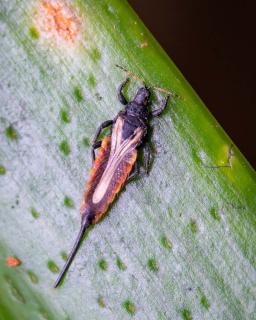 The two different sub-orders within the Thysanopthera order are Tubulifera and Terebrantia.
The two different sub-orders within the Thysanopthera order are Tubulifera and Terebrantia.
The very last segment of the abdomen at the tip of the thrips shows the main difference. You’ll need a magnifying glass to see this, usually:
- Members of the Tubulifera sub-order have a last segment that is long and cylinder-shaped, like a tube (hence the name). This group is also called Phlaeothripidae, which is the only family that is part of this sub-order. They also go under the common name “tube-tailed thrips“.
- Thrips of the Terebrantia sub-order have a pointed segment. A saw-like stinger called an ovipositor inside this pointed segment is how the female lays eggs inside plants. There are many families in this sub-order.
Each sub-order counts thousands of species. All types of thrips are found in each sub-order: pests and beneficial thrips, too.
Tubulifera
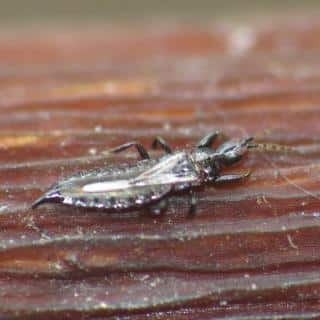 These thrips have tube-shaped tips. A few bristles stick out of the very end.
These thrips have tube-shaped tips. A few bristles stick out of the very end.
Tubulifera eggs are out in the open
Tubulifera thrips don’t wound plants to lay eggs inside them. They lack the jagged ovipositor that makes it possible. Eggs are laid and glued:
- in crevasses in bark
- wedged at leaf joints
- in folded flower buds
- in curled-up leaves that have been used for feeding
- on debris, under dead leaves
- in special cocoons for some species
Main Tubulifera thrips species
There are usually only a handful of Tubulifera species commonly encountered as a pest by gardeners, horticulturists and farmers.
- Cuban Laurel thrips – Gynaikothrips ficorum
- Galling thrips – Gynaikothrips uzeli
- Coffee curl thrips – Hoplandrothrips coffaea, H. marshall and H. bredoi
- Lily thrips – Liothrips vaneeckei
However, on the bright side, many of these are predator thrips. They eat eggs, larvae and nymphs of other insects and pests!
- Black hunter thrips – Leptothrips mali
- Tubular black thrips – Haplothrips victoriensis
Terebrantia
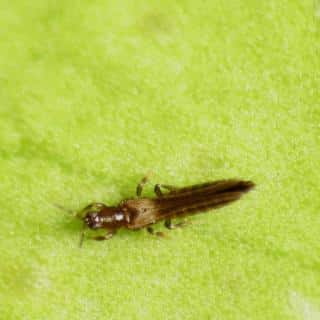 The cone-shaped tip hides a drill-like organ inside: the ovipositor (see one in this article on thrips eggs).
The cone-shaped tip hides a drill-like organ inside: the ovipositor (see one in this article on thrips eggs).
- There are bristles, too, but they mostly stick out of the next-to-last ring in the abdomen, not the very tip as in Tubulifera species (microscope needed for this observation).
Terebrantia eggs hidden inside plants
The saw-like ovipositor jags a wound into the flesh of a plant, in a soft spot. One or two eggs are laid inside, and then the mother moves to another nearby location.
- You can spot these thrips egg-nests by looking for white dots on plants.
- Stems of young wood, flower buds, leaf buds and leaf veins are good places to look for these white dots.
Development stages of Terebrantia thrips
Another characteristic is that members of this sub-order all go through two nymph instars and then two pupal instars as they grow.
Their development process goes as follows:
- egg
- first nymph instar
- second nymph instar
- first pupa instar (or prepupa)
- second pupa instar
- adult
Note that thrips feed only as nymphs and adults; not as eggs or pupa. More about the complete thrips lifecycle.
Main Terebrantia thrips species
Here are Terebrantia pest species commonly encountered by gardeners, horticulturists and farmers.
A few others, however, are beneficial thrips:
- Sixspotted thrips (or six banded thrips) – Scolothrips sexmaculatus
- Banded thrips – Franklinothrips species, especially Franklinothrips vespiformis, F. orizabensis and F. megalops
- Aeolothrips (also called banded thrips or banded-wing thrips) – Aeolothrips species
Smart tip about thrips species
If you notice thrips on your plants, try to check which species it is. It might be beneficial thrips that are helping you control aphids, spider mites and other pest thrips!


 The two different sub-orders within the Thysanopthera order are Tubulifera and Terebrantia.
The two different sub-orders within the Thysanopthera order are Tubulifera and Terebrantia. These thrips have tube-shaped tips. A few bristles stick out of the very end.
These thrips have tube-shaped tips. A few bristles stick out of the very end. The cone-shaped tip hides a drill-like organ inside: the ovipositor (see one in this article on thrips eggs).
The cone-shaped tip hides a drill-like organ inside: the ovipositor (see one in this article on thrips eggs).